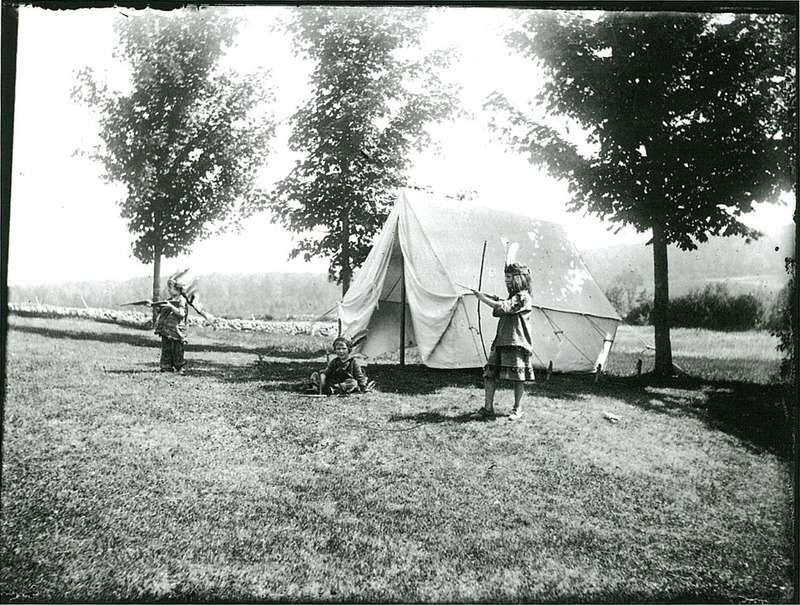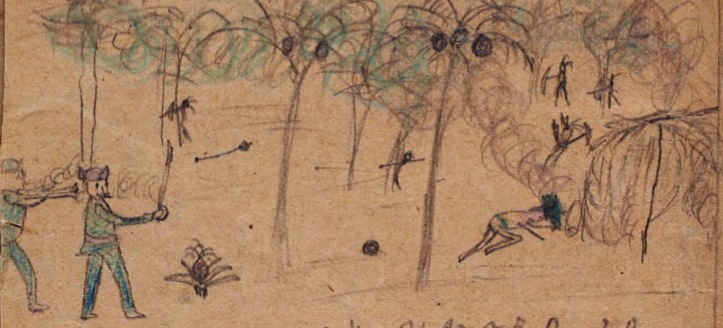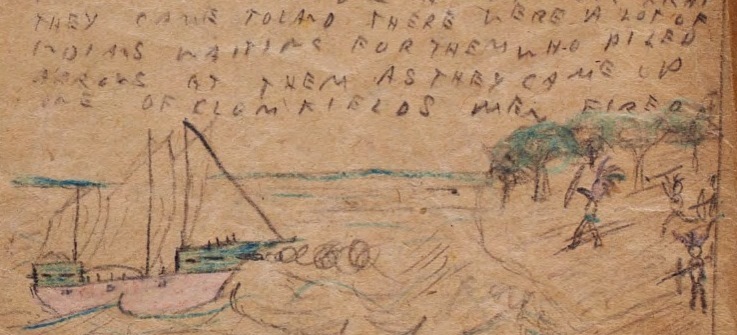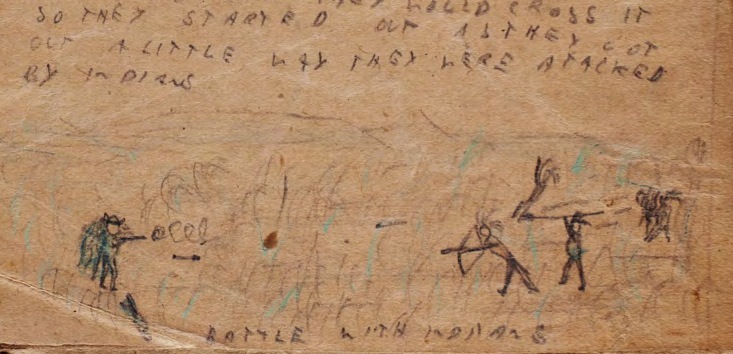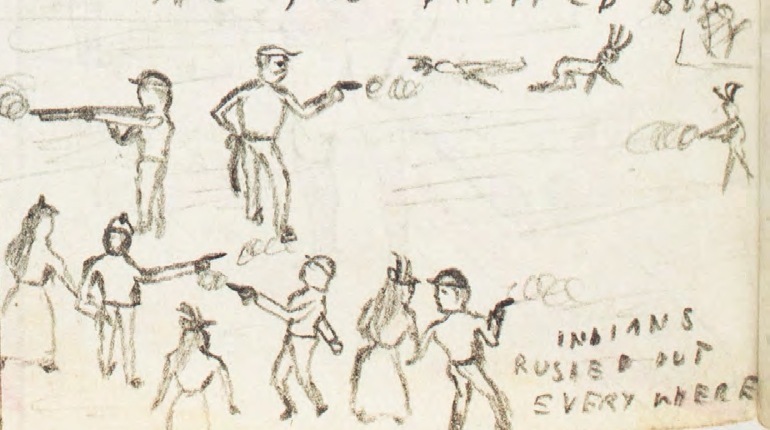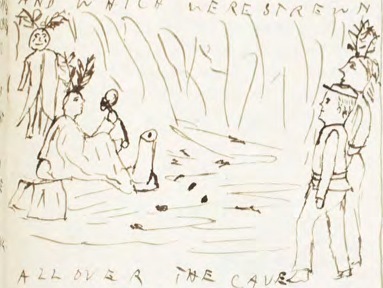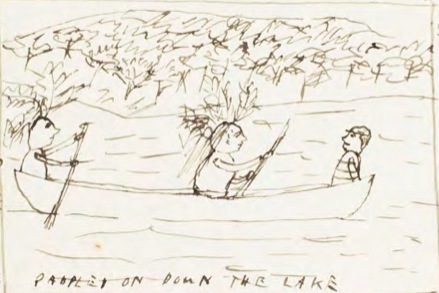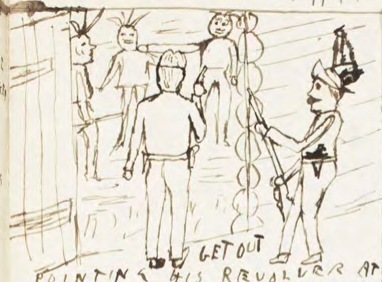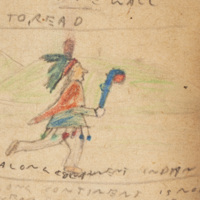Indians
Playing Indian
"Although our early play-times were not as important as our later outings they were as real and interesting as any, and our play-grounds witnessed many exciting conflicts and miniture battles. While we were living at Mill Village our play-grounds vacillated between the pasture, brook and "islands", from playing Indian, and naval engagements to war - "as the fit took us". Playing Indian was the most exciting game we played in those days and I hardly believe I should yell louder if I should see a genuine, wild-Indian than I did then. The last year or two, that we lived there we had a platform in a great spruce for the white-man's fort and our stratagems, surprises, and pitched-battles were blood-curdling in their intense reality and the neighbors said that we could be heard half-a-mile away as some body was being scalped by the wooden tomahawks or getting killed from ambush in the alders with milk-weed spears." ("Our Early Play Times", Sketches of Our Home Life Vol 1, p. 10)
Histories of Indian Warfare
The Nelson's "blood-curdling" games of Indian warfare clearly cast the "wild-Indian" as foe. Their histories of the island continents, however, detail these battles in a fairly even-handed way. This passage from The Complete History of Big Continent , for example, recognizes the Indian's desire to "have that land as their own" and describes a battle in which the losses are nearly equal on both sides:
"next day they started in three ships meen while at Big Continent the Clumfield Party were haveing their troubles at last the Indians wanted to get away with the whites and have that land as their own so one night they planned to kill all the people so one night they came but a friendly Indian had told Clumfields men and they were prepeared for them so as the first house was lit they fired in them the arrows flew fast at Clumfields men but at last the Indians rushed off in a panic in the morning they found that twelve of their men were killed one of which was Clumfield they had not any leader now. They found fifteen of the Indians were killed." (Complete History of Big Continent, chapter 1).
The illustrations to this history show far more Indian deaths than fallen white soldiers. These drawings do not disguise the violence of conquest, and there is real pathos in some of the brother's drawings of the Indian dead (look at the figure lying in fetus position in the first picture here).
It's clear that the Nelson brothers were inspired by real-life Indian encounters. Their region of New Hampshire had a long history of white and Indian conflicts. The explorer John Gunnison was the most famous native of Goshen and surely played a role in the boys' fantasies of exploration. Gunnison had fought the Seminoles and was killed by Pahvant Ute while on a surveying expedition to Utah for the Pacific Railroad. In the mid-1890s the Nelson family would move into the house where John Gunnison had been born.
One of their poems begins with a thinly veiled echo of a popular Christopher Columbus rhyme, "In fourteen hundred and ninety-two, Columbus sailed the ocean blue," taught to children to help remember when he set sail. This poem of "Discovery" is told from the perspective of Clumfield's sailors, but it does confront directly the question of what to do about "the red man there with his child and squaw." Interestingly the poem is presented in Chit Chat as the compostion of a woman, Ethan Allen's wife, Mary.
Childrens Column
Clumfields Discovery
In sixteen ninty two Clumfield sailed over the ocean blue.
His ships were small his sailors were few
The high waves beat up on its die
But still through the gale it did ride
Land was not sighted
And famin elighted
The sailors tore their hair
Wretched dispair
They cursed the air
They gaized at the sky so fair
Until land they sighted way over there
What land is this the captain cried
That way over ther in the haze I have spyed
They were struck with awe as they drew nearer and saw
The red man there with his child and squaw
They knew it was not their own native land
For there stood the mountains so close at hand
They sailors stood there in erresalute dispare
For they could not think how to scare
Those red men over there
I tell you said Clumfield
We will shoot the old springfield
The canon rang out
And the Indians ran into the woods with a shout
Mary Allen
Indians in The Youth's Companion
We know that the Nelson brothers were avid readers of The Youth's Companion, many articles in the magazine published during the 1890s featured Indian life. Youth's Companion never describes battles, but the magazine's stories often viewed Indians in a very negative light, featuring articles such as "Indians Outwitted" or "She Scared the Indians" that emphasize Indian stupidity and cowardice. Notice how often in the Nelson brothers' stories the Indians "panic." The Youth Companion story "Brave Grirls" tells of good little white girls setting traps for kineving Indians who attempt to break in when parents leave for the day. Such plots both mark Indians as threatening and demonstrates white children's superior intelligence and courage.
SOURCES
1. "Indians Outwitted," The Youth's Companion (Nov 3, 1892) 65, 44.
2. "She Scared the Indians," The Youth's Companion (Jan 17, 1895) 35.
3. "Brave Girls," The Youth's Companion (Feb 16, 1893) 66-7.
